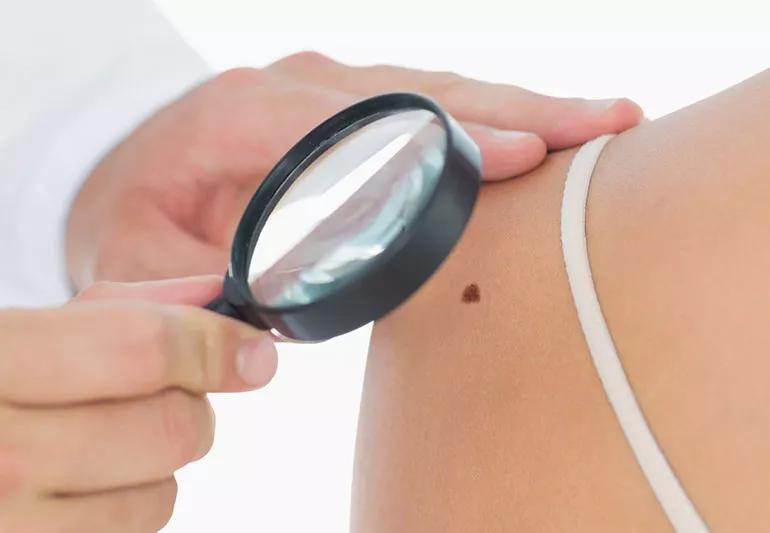Both skin cancers are increasingly affecting younger populations

Every year, as warmer weather begins to surface, we talk about the dangers of skin cancer and the importance of sun protection — all things that are true even during the gloomiest, coldest winter months.
Advertisement
Cleveland Clinic is a non-profit academic medical center. Advertising on our site helps support our mission. We do not endorse non-Cleveland Clinic products or services. Policy
And when we talk about skin cancer, we perhaps most often think of melanoma. As the most invasive skin cancer responsible for a majority of skin cancer deaths, it makes up only 1% of all skin cancers. So, what about the other 99%?
Over the last couple of decades, healthcare providers have noticed a sharp increase in two nonmelanoma skin cancers affecting younger populations: basal cell carcinoma and squamous cell carcinoma. These skin cancers in particular make up the majority of all skin cancers and pose a potentially greater risk for going unnoticed and untreated.
Dermatologist and skin cancer specialist Christine Poblete-Lopez, MD, explains the difference between these two skin cancers and why there’s been an increase in related cases.
Out of all types of skin cancer, roughly 75% are basal cell carcinoma and 20% are squamous cell carcinoma. The remainder are melanoma and other rare skin cancers.
“What we’re seeing is a general increase in skin cancers, but we’re starting to see it more in people who are in their 20s, 30s and 40s, where we use to find it in people who were in their 60s, 70s and 80s,” says Dr. Poblete-Lopez.
Basal cell carcinoma is the most common human cancer, with 3.6 million cases diagnosed each year. Both U.S. President Joe Biden and First Lady Jill Biden were diagnosed and treated for basal cell carcinoma early in 2023. For squamous cell carcinoma, the total number of cases has also been steadily increasing for three decades.
Advertisement
Part of the reason for these increases, particularly in younger populations, is because of an increased awareness around the importance of checking for skin cancer. But we’re also seeing an increase in these kinds of cancers because of prolonged sun exposure over time, an increased effect of ultraviolet (UV) rays on our skin and because these two types of skin cancers are often overlooked.
“A lot of people ignore these types of skin cancers because they’re often asymptomatic (show no symptoms),” says Dr. Poblete-Lopez. “They’re often just a little blemish. It’s not itchy, it’s not painful. And people will often ask, ‘Why do I need to treat this? It’s not giving me any problems.’”
But the problem is that eventually, if these skin cancers aren’t treated early enough, they can become more difficult to treat the larger they grow, and once you have skin cancer, you increase your risk for developing other types of skin cancer.
“These cancers are so common,” notes Dr. Poblete-Lopez. “But in people who neglect them, that’s where we see large skin cancers that have eroded through bone, muscle and so on.”
Here’s how these two types of cancers stand apart from one another:
The most common type of skin cancer, basal cell carcinoma, affects the basal layer of your epidermis, or the outer layer of your skin. This cancer is caused by a change in the DNA of your basal cells that makes them reproduce too many times. This is usually caused by an over-exposure to ultraviolet (UV) rays from sunlight or tanning beds. A genetic condition known as basal cell nevus syndrome can also increase your chance of acquiring this condition.
Basal cell carcinoma tends to appear like a pink little bump surrounded by blood vessels, but it can also develop a lavender hue. This kind of skin cancer doesn’t tend to metastasize (or spread) to other areas of your body, but it can grow anywhere on your body that’s been exposed to sunlight. Basal cell carcinoma is also slower-growing than squamous cell carcinoma.
“Because these grow very slowly, a lot of people just dismiss them and think of them as little pimples that aren’t healing,” says Dr. Poblete-Lopez. “Depending on where they are on your skin, they can also look red or scar-like.”
Squamous cell carcinoma is the second most common form of skin cancer caused by a genetic mutation that leads to an over-production of squamous cells near the top layer of your epidermis. Like basal cell carcinoma, this genetic mutation is caused by an over-exposure to UV rays.
Squamous cell carcinoma can appear anywhere on your body, but it’s more commonly found on the parts of your body that are exposed to the sun like your hands, arms, head and neck and the parts of your face that protrude like your nose, cheeks and ears.
Squamous cell carcinoma can appear as a dry, itchy or scaly pink patch of skin. Sometimes, it causes a growth or bump to appear that has a depression in the middle. This type of cancer also tends to bleed and scab in response to minimal trauma and tends to cover a larger surface area than basal cell carcinoma.
Advertisement
“Squamous cell carcinoma tends to be more pink and scaly,” notes Dr. Poblete-Lopez. “If you notice any pink or scaly patch that isn’t healing appropriately, you should bring it to a dermatologist’s attention.”
If you have acne, but one particular pimple or area doesn’t heal within three to six months, you should have it examined.
“We often hear stories of how people have noticed a problem that has been there for five or 10 years, but you shouldn’t wait that long,” advises Dr. Poblete-Lopez. “We’d rather reassure you that it’s nothing to worry about than have something brewing for five to 10 years. Keeping an eye on something that’s not healing appropriately is OK.”
Both kinds of cancer are serious, as they make up the majority of all skin cancers. But squamous cell carcinoma can also affect other areas of your body that have mucous membranes, like the inner lining of your organs, mouth, lungs and anus. And while it’s rare, squamous cell carcinoma metastasizes or spreads far more commonly than basal cell carcinoma.
“Aggressive squamous cell carcinomas have a less than 20% chance of spreading, but it can still spread,” explains Dr. Poblete-Lopez. “Those that spread are usually greater than 1 to 2 centimeters and are often located on the eyelids, nose, ears and lips and found on people who are immunosuppressed.”
Advertisement
Squamous cell carcinoma is more aggressive than basal cell carcinoma, particularly for people who are immunocompromised from the following:
“Immunosuppressive agents act like fertilizer to skin cancers,” says Dr. Poblete-Lopez. “People who have a compromised immune system are more prone to developing skin cancer.”
Basal cell and squamous cell carcinomas have the same treatment options because they fall under the category of nonmelanoma skin cancers. But treatment does vary depending on how aggressive the skin cancer is and where it’s growing.
For the more low-risk and slower-growing types, topical chemotherapy options are available, as well as electrodesiccation and curettage — an outpatient procedure where providers numb your skin before scraping off the cancer and burning the area with an electric probe to stop any bleeding. Other treatment options include:
“Standard surgical excision is typically recommended for low aggressive types of skin cancer that are growing in low-risk locations of your body,” says Dr. Poblete-Lopez. “For higher-risk locations and highly aggressive skin cancers, we recommend a procedure called Mohs micrographic surgery (Mohs).”
Advertisement
Mohs surgery is also an outpatient procedure, but it’s different from a standard surgical excision. Instead of removing the entire tumor in one go, providers cut away thin layers of skin affected by cancerous cells one layer at a time, examining each layer for cancerous cells under a microscope, and then repeating the process until no cancer cells are found.
“With Mohs surgery, we get a greater than 99% cure rate,” she adds. “By doing this procedure, we can tell you if we got everything or not. If we don’t get everything out on the first layer, we go back and we take a little bit more, but only in the areas we need to.”
If you have areas of your skin that you’re concerned about, or if you have patches of skin that aren’t healing within three to six months, you should schedule a skin cancer screening with a dermatology provider. And if you’re an adult who’s never had a skin cancer screening before, you may want to consider the option.
“Roughly 75% of your sun exposure happens before you turn 21, which means skin cancer begins developing many years before you may notice it appearing on the surface of your skin,” Dr. Poblete-Lopez explains.
And as always, sun protection is key. Wearing the right sunscreen every day and wearing sun-protective clothing helps minimize your risk for skin cancer. Other strategies like avoiding direct sun exposure during peak hours when the sun is highest can also help.
“We always advocate for sun protection,” says Dr. Poblete-Lopez. “You should make a habit of using sun protection on your sun-exposed skin 24/7 much like you take the time to brush your teeth twice a day.”
Learn more about our editorial process.
Advertisement

During an annual exam, your provider will check for any moles or spots that have changed in size, color or shape

Family history matters for melanoma, but the connection isn’t as strong for other skin cancers

Wear UPF clothing, apply sunscreen and try self-tanners instead of tanning beds

Mohs surgery removes most common skin cancers

The risk is less, but sunscreen is never a bad idea

Home remedies are unlikely to cure your contagious foot fungus — and they might even make it worse

To avoid swimmer’s eye, wear goggles, use eye drops and flush out your eyes with fresh, clean water when irritated

Earlobe piercings heal quicker and are less painful than cartilage piercings — proper cleaning and care are important

If you’re feeling short of breath, sleep can be tough — propping yourself up or sleeping on your side may help

If you fear the unknown or find yourself needing reassurance often, you may identify with this attachment style

If you’re looking to boost your gut health, it’s better to get fiber from whole foods